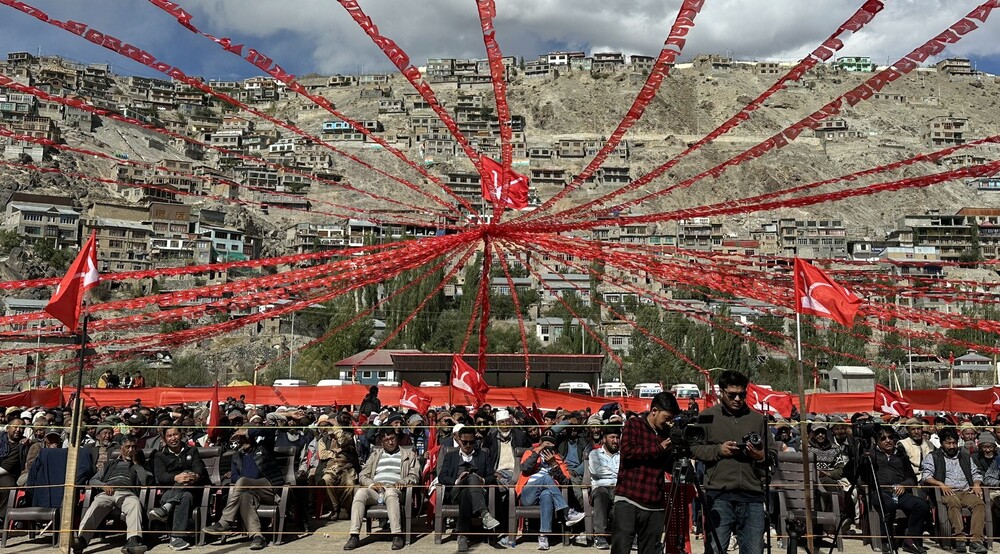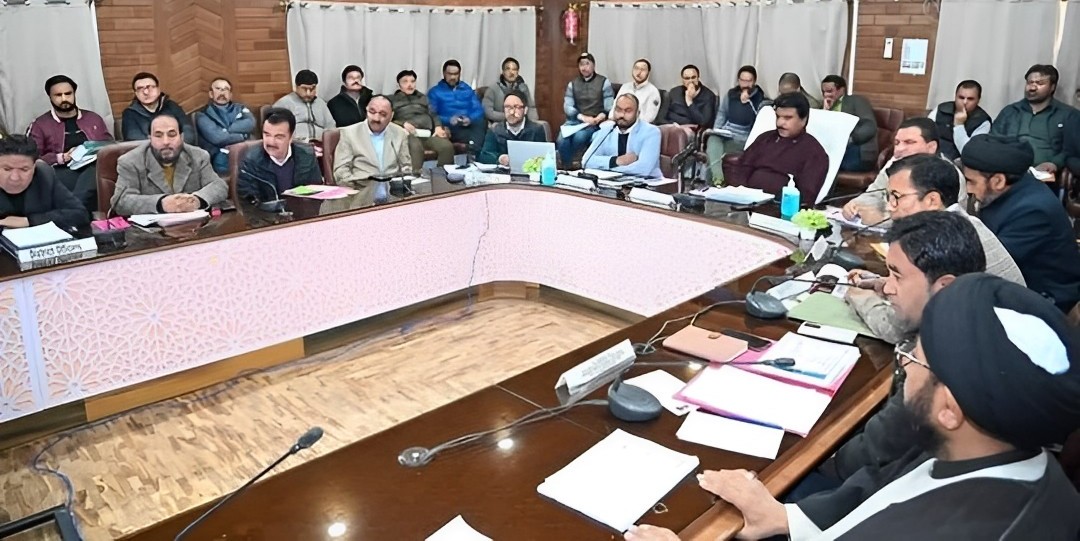In the interesting elections for the Ladakh Autonomous Hill Development Council (LAHDC), Kargil, allies JKNC and Congress contested against each other and took 22 of the 26 berths with two independents also belonging to the fold, reports Raashid Andrabi

The recently held electoral contest of significant consequence saw the Jammu and Kashmir National Conference (JKNC) and the Indian National Congress (INC) emerge as winners in the Ladakh Autonomous Hill Development Council (LAHDC) Kargil. While the outcome was very visible in anticipation, the story only got interesting as it witnessed many enigmatic twists, mostly indicating the apprehensions in the Leh Raj Bhawan.
The LAHDC Kargil election, held on October 4, 2023, marked a pivotal moment in the region’s politics. It was the first election conducted after the revocation of the special status of the erstwhile state in 2019. The same decision-making gave Ladakh an identity of a separate Union Territory without an assembly.
Dispute Over Symbol
This exercise was preceded by a legal battle over the use of the plough symbol by the JKNC. Several months before the LAHDC Kargil elections, the JKNC found itself embroiled in a legal dispute with the Ladakh administration over whether the Election Symbol Order of 1968 applied exclusively to assembly and parliamentary elections or extended to local body polls. The dispute escalated to the Supreme Court, which intervened decisively, overturning the LAHDC election notification and imposing a fine of Rs 1 lakh on the Ladakh administration.
In this election, the Congress and JK National Conference (JKNC) allied to secure a majority. The Congress claimed victory on 10 seats, while the JKNC secured 12 out of the 26 available seats. Despite being allies, it was technically a contest between the two parties.
Campaign Highlights
Key candidates from the JKNC, Congress, and other notable parties played pivotal roles in the campaign. High-profile visits from prominent political leaders, such as Rahul Gandhi’s visit in August, ignited passionate rhetoric in the region. Gandhi’s visit involved engagements with various sections of society and a rally in Kargil, where he raised concerns about the alleged occupation of Chinese territory in Ladakh.

Former Chief Minister and senior JKNC leader Omar Abdullah also actively campaigned for his party. He voiced strong objections to the BJP’s approach, alleging an open display of ‘hatred’ towards Muslims and contending that the BJP had lost its moral standing to seek votes in the region.
Voter Turnout
A total of 74,026 voters participated, including 46,762 women exercising their voting rights. The election took place across 278 polling stations in Kargil, with 85 candidates vying for council seats. Notably, the voter turnout reached 78 per cent, marking an 8 per cent increase from the 2018 council election. This surge in participation was largely attributed to the return of Kargil’s migrant population.
The Congress fielded 22 candidates, the JKNC and Bhartiya Janta Party (BJP) both had 17 candidates, and the Aam Aadmi Party (AAP) contested four seats, with an additional 25 Independent candidates participating.
The Alliance’s Focus
The alliance concentrated its efforts in regions with stiff competition from the BJP. Throughout the election campaign, the spotlight shifted away from local issues, with Kargil’s dissatisfaction with its Union Territory (UT) status and abrogation of Article 370 taking centre stage. Candidates from various political parties, except the BJP, rallied around this issue, promising to address it effectively.
The BJP relied on its developmental achievements and increased funding for the Hill Councils in Kargil and Leh. However, its wavering stance on granting exclusive rights to locals regarding employment and land ownership contributed to its sudden loss of popularity.
In Drass, one of the world’s coldest regions with winter temperatures plummeting to around minus 40 degrees Celsius, Kashmir remains the first love. In the past, the treacherous route from Srinagar to Drass, marred by snowfall and slippery roads, posed life-threatening risks, and most local schools were run by Kashmiri teachers.
The architectural influence of Kashmir is evident in Kargil homes, featuring sloped tin-style roofing and wooden windows. In Kargil’s Mushkoh Valley, Shina-speaking people share more similarities with Kashmir’s Gurez Valley than any other region. Shina is an Indo-Aryan language prevalent in Gilgit Baltistan on the other side of the LoC.
Political Influences
In Kargil, politics is dictated not by political parties but by two religious seminaries – the Imam Khomeini Memorial Trust (IKMT) and the Islamia School Kargil (ISK). The IKMT, which emerged in the late 1980s as a consequence of the 1979 Iranian revolution led by Imam Khomeini, has traditionally supported the Congress. It was established to disrupt the influence of the ISK, which had backed the JKNC since the 1950s. Both seminaries vehemently oppose the division of Jammu and Kashmir into two Union Territories, particularly the separation of Kargil from Kashmir.
In the recent elections, the people of Kargil cast their votes against the idea of detachment from Kashmir. This sentiment is shared among voters and local leaders.
Results and Implications
In the aftermath of the tally, the JKNC and Congress emerged as the key players. The JKNC secured 12 seats, while Congress clinched 10 in the Ladakh Autonomous Hill Development Council (LAHDC). However, the real story lies in the numbers, the votes parties polled. Congress garnered 25,764 (35.23 per cent) votes out of the 73,114 cast, taking the lead, while the JKNC trailed with 21,580 votes (29.51 per cent).

The BJP, on the other hand, faced setbacks in the election, securing 8,479 votes (11.59 per cent). The party managed to clinch victories in two closely contested constituencies – Padma Dorjey in the Stakchay Khangral Constituency and Stanzin Lakpa in the Cha Constituency. Nevertheless, many perceive these triumphs as a stroke of fortune, eclipsed by the overarching performance of Congress and JKNC in the LAHDC-Kargil elections.
The Ladakh Autonomous Hill Development Council (LAHDC) serves as the governing body for the district’s developmental needs, led by a Chief Executive Councillor and four executive councillors. Their primary role is to supervise the functions of various government departments alongside the secretaries of the Union Territory (UT) administration. The LAHDC’s control is regarded as essential by local leaders to protect the region’s interests from the central government’s oversight through the Lieutenant-Governor (L-G) administration.
Diminished Influence
However, following the reorganization of Ladakh into a Union Territory and the abrogation of Article 370, which had granted the LAHDC significant legislative powers, the council’s influence has dwindled. LAHDC councillors now find themselves with limited authority and diminished decision-making capabilities. The councils, initially empowered by the sixth schedule, which granted legislative, judicial, and administrative powers, related to local administration, police, sanitation, health, and marriage, have seen their powers curtailed.
This decline in authority has led to widespread discontent among the people of Kargil, and the recent LAHDC-Kargil poll results are being hailed as a response to the government’s decision to abrogate Article 370 and bifurcate Jammu and Kashmir.
Local Perspectives
Haji Muhammad Hanifa Jan, JKNC District President Kargil and a KDA Member emphasised the diminished influence of the Hill Council, stating that it has transformed from a powerful entity to a mere shadow, no longer self-contained. The power structure now heavily relies on bureaucracy, with limited consultation and accountability. “The primary role of the Hill Council was to address development issues,” Jan said. “Now, their influence has decreased significantly. It is no longer a self-contained entity. What was once ‘power’ is now a mere shadow and it rests outside the council’s grasp.”
Sajjad Kargili, an activist and member of the Kargil Development Alliance (KDA), anticipates a challenging road ahead for the BJP, attributing their electoral loss to the dissatisfaction of the local populace with the decision to designate Ladakh as a Union Territory and the revocation of Article 370.
“The election results mirror the populace’s dissatisfaction with the BJP’s decision to designate Ladakh as a Union territory, coupled with their divisive actions, especially the revocation of Article 370 in Jammu and Kashmir,” Sajad said. “They have lost badly because they don’t know the ground demand. People want statehood, many even want to be merged with Jammu and Kashmir again.”
The Sixth Schedule
Notably, there had been hopes of extending the Sixth Schedule to Ladakh after the National Commission for Scheduled Tribes (NCST) recommended it in 2019. The commission argued that over 97 per cent of the region’s population was tribal and that including Ladakh under the Sixth Schedule would enable democratic devolution of powers, preserve the region’s culture, protect land rights, and enhance the transfer of funds for development.
Union minister Anurag Thakur had initially expressed the central government’s commitment to this extension, but since then, the government’s stance has become ambiguous, contributing to the discontent in the region.
Dissatisfaction
Sajjad Khan, the elected representative of the Saliskote constituency, stated, “Following the abrogation in 2019, Ladakh found itself without a legislative framework, resulting in a loss of our democratic rights. Our fate now rests within the confines of bureaucracy. It is evident that the Hill council is at a critical juncture, requiring substantial empowerment, but we often receive unfulfilled promises.”
“Since August 2019, there has been no legislature here,” Khan added. “All authority resides with the Secretaries, leaving councillors with no power. This situation leads towards bureaucracy rather than democracy. The power of nominated seats rests with the governor, with the consent of councillors, which currently is not the case. The UT administration interferes in all aspects of governance.”















